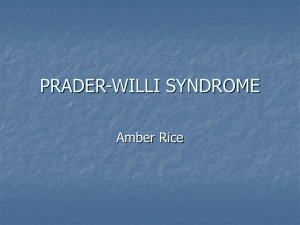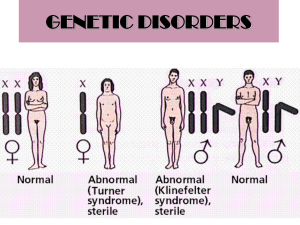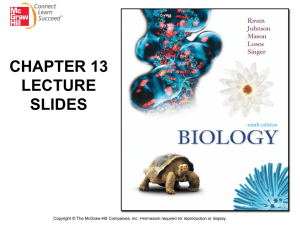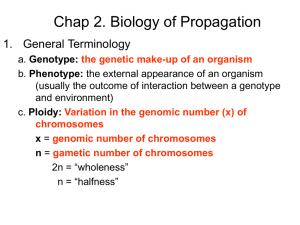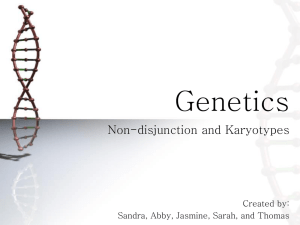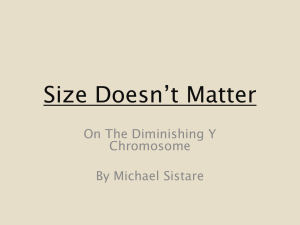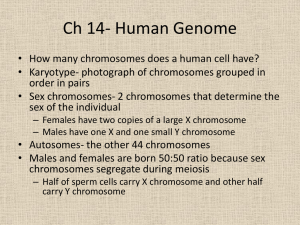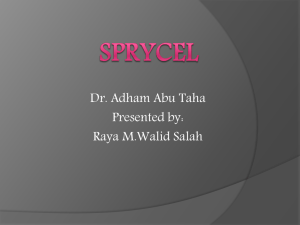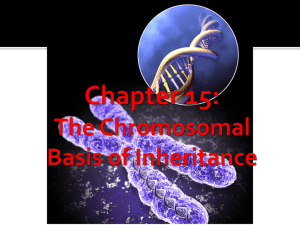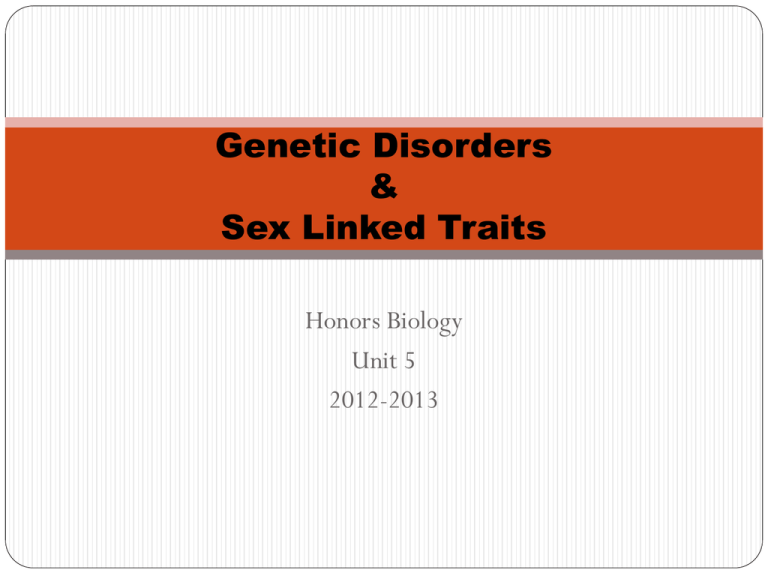
Genetic Disorders
&
Sex Linked Traits
Honors Biology
Unit 5
2012-2013
Recessive Disorders
Disorders that are only expressed in
the phenotype when 2 recessive alleles
are present.
DD = Normal
Dd = Carrier
dd = Affected by disorder
2 Examples
of Recessive Disorders
Tay-Sachs Disease
A genetically caused disease in which the
gene to make the enzyme Hex-A
(Hexosaminidase A) is not working.
Hex-A is an enzyme that breaks down the
lipid GM2 ganglioside.
Without Hex-A this lipid accumulates on
nerve cells, specifically in the brain causing
severe brain damage.
Victims of this disease to not live past age 5
Common in Eastern European Ashkenazi Jews
This is a group of
people descendent of
medieval Jews from
the Rhineland area.
(Rhineland: near the
river Rhine in
Germany)
Common in this
population (1 in 30)
Tay-Sachs Brain
How is Tay-Sachs disease passed?
Each parent must be a Carrier
Offspring:
25% Normal
50% Carriers
25% Tay-Sachs
Cystic Fibrosis
Thick mucus is produced by the body
Mucus fills lungs causing lung infections
Mucus blocks pancreas which causes digestive
problems
Mucus can block bile ducts in liver causing liver
failure.
Cystic Fibrosis
Cystic Fibrosis
Most common in Caucasian
(white) populations
(1 in 2500 to 3500)
1 in 17,000 African Americans
1 in 31,000 Asian Americans
Carriers of Cystic Fibrosis
Offspring:
25% Normal
50% Carriers
25% Cystic Fibrosis
Dominant Disorders
Disorders that are expressed in the
phenotype of heterozygous and
homozygous dominant individuals
DD = Affected
Dd = Affected
dd = Normal
2 Examples
1) Huntington’s Disease
Brain cells degenerate over time
Mood swings, loss of muscle control, loss of memory and
inability to learn, death.
Usually adult-onset, appears around ages 40-50
Outlook is 10-15 years of survivablity
hh = Normal
HH or Hh = will get and die of this
disease
Person with Huntington’s and a person
without Huntington’s
Hh x hh
Offspring:
50% Huntington’s
50% Normal
Huntington’s is most common in certain parts of
Venezuela (700 in 100,000)
Generally affect 3-7 in 100,000 of European ancestry
Less common in African-American & Asian American
2) Marfan’s Syndrome
Defective gene for fibrillin-1 that results in
abnormal connective tissue
Aorta may stretch or become weak, causing aortic
rupture, the leading cause of death
Eye/lens problems
Excessive long bone growth (long arms & fingers)
Hypermobile joints (too flexible)
Chromosome Structure
Variations
Chromosomes can be broken by X-rays and by certain
chemicals. The broken ends spontaneously rejoin, but if
there are multiple breaks, the ends join at random. This
leads to alterations in chromosome structure.
Breaking the chromosome often means breaking a gene.
Since most genes are necessary for life, many
chromosome breaks are lethal or cause serious defects.
Also, chromosomes with structural variations often have
trouble going through meiosis, giving embryos with
missing or extra large regions of the chromosomes.
Chromosome Structure
Variations
The major categories:
duplication (an extra copy of a region of chromosome)
deletion (missing a region of chromosome)
inversion (part of the chromosome is inserted backwards)
translocation (two different chromosomes switch pieces).
Chromosome Variations
Changes in number and structure are possible: first look at
number variations.
Aneuploidy: having an extra or missing chromosome– is fairly
common in sperm and eggs. Errors in meiosis causes
chromosomes to not separate equally into the gametes.
The rate of aneuploidy
in males is constant:
1-2% of sperm have
an extra or missing
chromosome.
Chromosome Variations
In females, the rate increases
with age. This is illustrated by
the frequency of Down
syndrome births at different
ages of mother. Down
syndrome is the most frequent
result of aneuploidy.
Chromosome Number Variations:
Aneuploidy
Except for the X and Y, humans don’t survive with
only 1 copy of any chromosome. Also, 3 copies is
lethal in most cases. Aneuploidy is a major cause of
spontaneous abortion in early pregnancy.
Down Syndrome is the most common human
aneuploidy. It is also called trisomy-21, meaning 3
copies of chromosome number 21.
Trisomy:
*Having 3 chromosomes of each kind
instead of 2
*Normally trisomy results in death.
1 Example
Down Syndrome:
a genetic condition in which the individual has 3
copies of the 21st chromosome.
Genotype: 3 copies of 21st chromosome
Down Syndrome:
Phenotype: People with Down’s have a characteristic appearance:
flattened face, turned up nose, epicanthal folds at the outer corners of
the eyes. In most cases the diagnosis is made immediately at birth.
Heart defects, protruding tongue, and mental retardation are also found
in most people with Down’s. Occurs about 1 in 1000 births.
Sex Linked Traits
Sex Linked Traits
Traits that occur on the X or Y chromosome
X-linked traits are traits found on the X Chromosome
Sex-linked Genes
Genes on the X chromosome are called “sex-
linked”, because they expressed more often in
males than in females
There are very few genes on the Y chromosome.
Since males only have one X chromosome, all
genes on it, whether dominant or recessive, are
expressed.
Sex-linked Genes
In contrast, a mutant gene on an X chromosome in a
female is usually covered up by the normal allele on the
other X. Most mutations are recessive. So, most
people with sex-linked genetic conditions are
male.
Another fact about sex-linked genes. Males produce ½
their sperm with their X chromosome, and half with
their Y chromosome. The X-bearing sperm lead to
daughters and the Y-bearing sperm lead to sons. So, sons
get their only X from their mothers, and the father’s X
goes only to daughters.
The Y chromosome is passed from father to son.
Why can females have 2 copies of the X
chromosome, when 2 copies of most
chromosomes is deadly?
Answer:
In each cell one of the X chromosomes ‘turns off’.
This turned off chromosome is known as a Barr
body.
The effect of Barr bodies can be seen in Calico
colored cats.
Why can females have 2 copies of the X chromosome, when 2
copies of most chromosomes is deadly?
Example: Calico Colored cats.
A calico cat has patches of orange and patches of black
X = orange X1 = black
Males: XY = orange / X1Y = black
Females: XX = orange / X1X1 = black / XX1 = calico
Because individual cells determine which X chromosome
to deactivate, the patches of color arise
Colorblindness
We have 3 color receptors in the retinas of our eyes.
They respond best to red, green, and blue light.
Each receptor is made by a gene. The blue receptor is
on an autosome, while the red and green receptors are
on the X chromosome (sex-linked).
Colorblindness
Most colorblind people are males, who have
mutated, inactive versions of either the red or
the green (sometimes both) color receptors.
Most females with a mutant receptor gene are
heterozygous: the normal version of the receptor
genes gives them normal color vision.
Colorblind Test!
You will see circles with many colors of
dots
The dot pattern makes up a number
What number do you see?
With Color Vision:
This one you can even see in black and
white
Color Blind Test
What
number
do you
see?
Color Blind Test
What
number
do you
see?
This what you would see if you were
color blind
What
number
do you
see?
Color Blind Test
What
number
do you
see?
Color Blind Test
What
number
do you
see?
Color Blind Test
What
number
do you
see?
Color Blind Test
What
number
do you
see?
With color vision you see this:
But if you were red-green colorblind….
You would see the #:
5
What do the colorblind see?
Types of Colorblindness
NORMAL
RED
YELLOW
GREEN
CYAN
BLUE
MAGENTA
PROTAN:
DEUTERAN:
TRITAN:
Red Blind
Green Blind
Blue Blind
Types of Colorblindness –
Normal
Protanopia: no red
No color vision
Deuteranopia: no green
Tritanopia: no blue
How to write Alleles for X-Linked Traits
Women:
Normal: XBXB
Carrier: XBXb
Colorblind: XbXb
Men:
Normal: XBY
Colorblind: XbY
Hemophilia
Hemophilia is a disease in which the blood does not clot when
exposed to air. People with hemophilia can easily bleed to death
from very minor wounds. Hemophilia is another sex-linked
trait.
Hemophilia is treated by injecting the proper clotting proteins,
isolated from the blood of normal people. In the early 1980’s,
the blood supply was contaminated by HIV, the AIDS virus, and
many hemophiliacs contracted AIDS at that time.
Small cuts, scrapes and bruises can be life threatening
1 in 10, 000 males
1 in 100,000,000 females
Common amongst royalty in Europe
Queen Victoria
= Carrier
Turner Syndrome
Also called XO, because people with
Turner’s have only 1 X chromosome
No Y means Turner’s people are
female. However, no ovaries
develop, so they don’t undergo the
body changes of puberty and they
are sterile.
Hormone treatment cures all but the
sterility.
Other symptoms: short stature,
webbed skin and low hairline at the
neck, some oddities of spatial
perception. Not retarded.
Klinefelter Syndrome
Non-disjunction can also result in a
person with 2 X’s and a Y: XXY. This
is called Klinefelter Syndrome.
The Y chromosome makes a person
with Klinefelter’s male: possessing
testes.
Symptoms: female body hair pattern,
breast development, sterile, can be
some developmental delay or
retardation, especially for verbal
skills.
Often not diagnosed, or diagnosed
only accidentally.
Most symptoms are helped by
testosterone treatment.
Other Number Variations
Triplo-X, having 3 X chromosomes. No Y chromosome
means female. Many with this syndrome are undiagnosed
because they have no symptoms. Some have slight social and
developmental problems, especially language-related.
Occasional fertility problems, but many have normal fertility.
Not well studied.
XYY: having 2 Y chromosomes plus an X. Male because they
have a Y. Many are never diagnosed due to a lack of
symptoms. Tend to be taller, more physically active, slightly
retarded, prone to acne.
A few oddities
It is possible to be XY and female. Two ways this can happen:
1. the SRY gene can be inactivated by a mutation. If SRY
doesn’t work, testes don’t develop and the embryo develops as
a normal female.
2. In a condition called “androgen insensitivity”, the person
is XY with a functional SRY gene, but her cells lack the
testosterone receptor protein, so the cells don’t ever get the
message that the testosterone is sending. Testes develop in the
abdominal cavity, and no ovaries, fallopian tubes, or uterus
develop. At puberty, the internal testes secrete testosterone,
which gets converted into estrogen and the body develops as a
normal (but sterile) adult female.
XY women show some “male-like”
features that make them good models
Taller than most women
Chiseled Jaw:
Good Muscle definition:
Don’t have as much body fat
Hermaphrodites ?!?
Hermaphrodite: An individual that
has all female reproductive parts, and
all male reproductive parts
No such thing in Humans
Hermaphrodites
In some cases, androgen insensitivity is only partial: the cells
respond a little bit to testosterone produced by the testes. The
embryo develops with ambiguous genitalia, neither
completely male not completely female.
Another condition, congenital adrenal dysplasia, causes the
adrenal glands to produce an abnormally large amount of
testosterone in a female embryo, This can also cause
development of ambiguous genitalia.
Another rare condition: a chimera occurs when two separate
embryos fuse together. This can result in a person with some
XX cells and some XY cells. This condition is extremely rare:
more people say they have it than actually do.
Twins
2% of births
Monozygotic (Identical) 30% of twins
A single zygote splits into two. This happens between 1 to 9 days after the zygote forms.
The twins share the same genome
Dizygotic (Fraternal) 70% of twins
Two separate eggs are fertilized with two separate sperm. Two totally independent
zygotes are created.
The twins have different genomes
Conjoined twins – very rare (1 in 200,000)
Identical twins who fail to completely separate after the 13th day after fertilization
This may be due to the fusion, or incomplete separation of zygotes
May be two fully formed individuals connected at various locations, or rarely, parasitic
twins, where one is much smaller and less formed, or even completely contained.
Sex-Influenced Traits
Some traits appear to be specific to one
sex, but are not sex-linked: their genes
are not on the X chromosome. It is
sex-influenced.
The best human example is male
pattern baldness.
Baldness is dominant in males:
heterozygotes and homozygotes both
become bald. In females, baldness is
recessive: only homozygotes (which are
relatively rare) become bald. Also,
females tend to lose hair more evenly
than men, giving a sparse hair pattern
rather than completely baldness.


